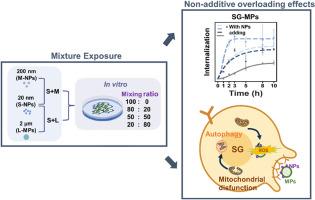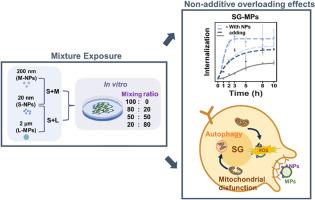双壳类动物免疫系统中的搭便车者:混合微塑料和纳米塑料引发血细胞自噬
IF 7.3
2区 环境科学与生态学
Q1 ENVIRONMENTAL SCIENCES
引用次数: 0
摘要
天然微塑料和纳米塑料(MNPs)混合物通常由多种尺寸组成,但它们的共存如何影响水生生物的免疫系统尚不清楚。在这里,我们定量跟踪并证明了这种异质性在非加性模式下动态地重塑了双壳红细胞负荷,并对免疫功能产生亚群体特异性后果。动力学模型揭示了不同的内化模式和选择性的血细胞亚群,由颗粒比例和摄取动力学驱动。粒细胞表现出不分青红皂白的MNP内化能力,在不同的颗粒组成中保持较高的吸收效率。相比之下,半粒细胞表现出对颗粒大小分布敏感的选择性内化行为,随着纳米颗粒比例的变化,促进优先摄取转移。从机制上讲,大的NPs通过搭便车效应加速了小的NPs的内化,但同时竞争细胞内加工途径,限制了最大的摄取。值得注意的是,与较小的NPs共同暴露可显著增强和加速MPs内化,导致细胞内超载,伴有严重的溶酶体损伤和线粒体损伤。这些破坏可能引发线粒体-溶酶体串扰和自噬,在半粒细胞中尤其明显。最终,与单独暴露于单个颗粒相比,多种颗粒大小的联合存在导致血细胞吞噬能力的级联损伤,强调颗粒大小的相互作用是免疫毒性的关键决定因素。我们的研究结果强调了血细胞亚群的协调处理如何影响混合大小的塑料清除,为MNPs对海洋生物构成的健康风险提供了新的见解。本文章由计算机程序翻译,如有差异,请以英文原文为准。


Hitchhikers in bivalve immune system: Mixed microplastics and nanoplastics triggers hemocyte autophagy
Natural microplastic and nanoplastics (MNPs) mixtures generally consist of multiple sizes, but how their co-existence influences the immune system of aquatic organisms remains elusive. Here, we quantitatively tracked and demonstrated that such heterogeneity dynamically reshaped bivalve hemocyte burden in non-additive modes with subpopulation-specific consequences for immune function. Kinetic modeling revealed distinct internalization patterns and selectivity among hemocyte subpopulations, driven by particle proportions and uptake dynamics. Granulocytes displayed indiscriminate capacity for MNP internalization, maintaining high uptake efficiency across varying particle compositions. In contrast, semigranulocytes showed selective internalization behavior sensitive to particle size distributions, facilitating preferential uptake shifts as nanoparticle proportions varied. Mechanistically, large NPs accelerated the internalization of smaller NPs via a hitchhiking effect but simultaneously competed for intracellular processing pathways, limiting maximal uptake. Notably, co-exposure with smaller NPs significantly enhanced and accelerated MPs internalization, leading to intracellular overload with severe lysosomal damage and mitochondrial impairment. These disruptions potentially triggered mitochondria–lysosome crosstalk and autophagy, particularly pronounced in semigranulocytes. Ultimately, the combined presence of multiple particle sizes resulted in cascading impairment of hemocyte phagocytic capacity than exposure to individual particles alone, highlighting particle-size interactions as critical determinants of immunotoxicity. Our findings underscored how coordinated disposal of hemocyte subpopulations influenced the mixed-size plastic clearance, providing new insight on the health risks posed by MNPs to marine organisms.
求助全文
通过发布文献求助,成功后即可免费获取论文全文。
去求助
来源期刊

Environmental Pollution
环境科学-环境科学
CiteScore
16.00
自引率
6.70%
发文量
2082
审稿时长
2.9 months
期刊介绍:
Environmental Pollution is an international peer-reviewed journal that publishes high-quality research papers and review articles covering all aspects of environmental pollution and its impacts on ecosystems and human health.
Subject areas include, but are not limited to:
• Sources and occurrences of pollutants that are clearly defined and measured in environmental compartments, food and food-related items, and human bodies;
• Interlinks between contaminant exposure and biological, ecological, and human health effects, including those of climate change;
• Contaminants of emerging concerns (including but not limited to antibiotic resistant microorganisms or genes, microplastics/nanoplastics, electronic wastes, light, and noise) and/or their biological, ecological, or human health effects;
• Laboratory and field studies on the remediation/mitigation of environmental pollution via new techniques and with clear links to biological, ecological, or human health effects;
• Modeling of pollution processes, patterns, or trends that is of clear environmental and/or human health interest;
• New techniques that measure and examine environmental occurrences, transport, behavior, and effects of pollutants within the environment or the laboratory, provided that they can be clearly used to address problems within regional or global environmental compartments.
 求助内容:
求助内容: 应助结果提醒方式:
应助结果提醒方式:


